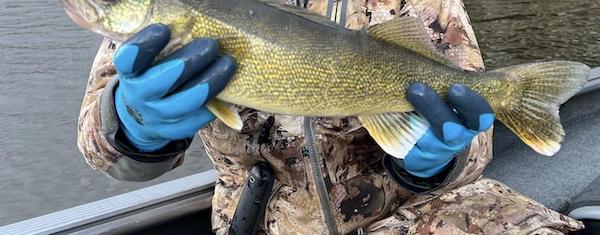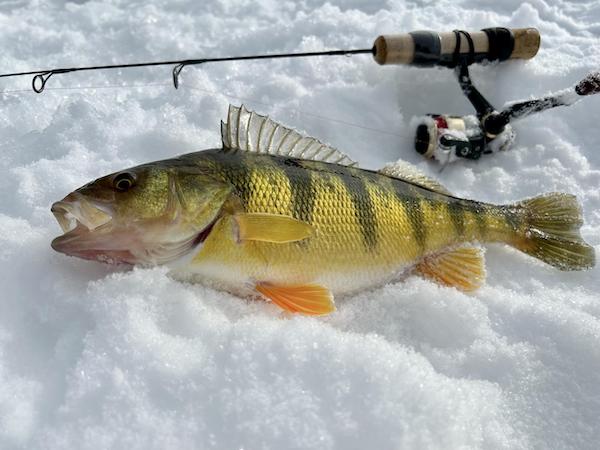
On The Trail Of An Illegal Walleye Stocker
THE FOLLOWING IS A PRESS RELEASE FROM THE IDAHO DEPARTMENT OF FISH AND GAME
A research team concluded the walleye caught in Lake Cascade in May 2022 was not born in the reservoir and was illegally put there roughly 2 years before it was caught. Biologists compared the walleye’s chemical signatures with three perch that lived their entire lives in Lake Cascade to characterize the chemical signature of the lake. When they analyzed the walleye’s otolith (ear bone), they found it matched the chemical signature in Lake Cascade, but only for the past two years.

The walleye was second reported caught out of Lake Cascade in four years. https://idfg.idaho.gov/press/fg-confirms-second-report-walleye-caught-lake-cascade
Mike Thomas, Regional Fisheries Biologist in McCall, and his team need to know how many other walleye may be out there, and if they’re reproducing, which could change the Lake Cascade’s famous perch fishery and likely end the era of its famed “jumbo” perch that have made the reservoir a national destination for anglers.
Biologists are trying to learn where the walleye came from, and how long they’ve been in Lake Cascade. And they partnered with a team of research scientist to help get answers.
Thomas was fishing with friends in May 2022 when a friend caught the walleye. Luckily, Thomas was able to bring that fish back to the Fish and Game office in McCall to collect some samples and start searching for answers to some of their questions. The big question the team immediately focused on was whether or not this fish was born in Lake Cascade. To answer that question, the team took the otoliths (inner ear bones) from the walleye and sent them to a research team from NOAA Fisheries, UC Santa Cruz, and UC Davis Center for Watershed Sciences in California who specialize in using information recorded in otoliths to answer many types of questions in fisheries.

Otolith microchemistry analysis
When fish grow throughout their life, their otoliths grow too (just like our bones). Many anglers are aware that biologists can count the rings in an otolith to determine the age of a fish – just like with rings on a tree trunk. Perhaps less commonly known is that, as the otolith is growing, the chemical signature of the water in which they are growing gets incorporated into the bone.
One of the specialties of this collaborative research team is otolith microchemistry analysis. This is a technique used in fisheries management in which a laser and mass spectrometer is used to read the chemical signatures in sequential layers of a fish otolith.
Scientists can determine several things from the differences in chemical signatures between waterbodies, including fish movement, habitat use, and natal origin. So, when the research team reads the chemical signature on an otolith, they can determine at what points in time a fish moves between waterbodies with significantly different chemical signatures.
“We are excited to use the tools we have developed to track fish movements to help our Fish and Game partners solve the walleye mystery” said Malte Willmes a researcher with UC Santa Cruz who has used this approach to understand human and fish migrations.
“We have never used otolith microchemistry in a forensics case, but it is clear that it is a powerful tool” added Rachel Johnson with NOAA Fisheries and UC Davis and lead of the research team.
“We were all holding our breaths when the data was coming off the instrument to see if there was evidence that this walleye was reproducing in the lake” said George Whitman at UC Davis and senior analyst for the team.
Prior to 2020, there was a very different chemical signature in the walleye otoliths, which indicates this walleye – which was four years old when it was caught in 2022 – was illegally transplanted into Lake Cascade as a two-year old in 2020.
“Mystery solved!” said Carson Jefferes with UC Davis Center for Watershed Sciences. “I haven’t seen such definitive isotope data. I was relieved to learn that there wasn’t a self-sustaining population in Lake Cascade.”

Finding the answers to remaining questions
Whether the walleye originated in Cascade is not the only question biologists have been working to answer since this fish was caught. McCall fisheries staff have been monitoring for walleye – both through targeted efforts immediately after the fish was caught, and opportunistically in their extensive surveys of the lake this year – and have yet to turn up another walleye. There have been no additional reports of anglers catching walleye at Lake Cascade, either. While this information doesn’t allow biologists to determine how many other walleye are in Lake Cascade, it does suggest that abundance of walleye is very low.
“At this point, we have seen nothing to indicate that walleye have successfully established themselves in Lake Cascade, which is good news,” said Jordan Messner, McCall Regional Fisheries Manager.
One question that remains is where this walleye came from. Fish and Game staff are continuing to partner with the research team, as well as the Laboratory for Integrative Fish Ecology at the University of Idaho to help answer that question. The collaborative team is planning to develop a ‘library’ of chemical signatures from known walleye waters in the state. Once that library is built, Fish and Game will have the ability to determine the source of some of these illegal introductions. That could help inform enforcement efforts geared at finding a culprit – or at least help to put a stop to illegal transplanting of walleye at the source.
Illegal fish introductions are occurring, and it has potential to greatly impact public resources
Illegal walleye introductions are a sore subject for fish managers across the west. Yes, walleye are some of the best-eating freshwater fish in existence, and they are a favorite sportfish of many anglers. However, walleye are voracious predators and the ecosystems in their native ranges are far more productive with a diverse and plentiful forage base. Western waters are sterile in comparison and the lack of forage fish and minnows mean that walleye will likely be eating sportfish in western waters.
There are countless examples across Utah, Wyoming, and Washington, of prized sport fisheries being impacted or decimated by illegal walleye introductions. Illegal introductions generally result in precious management resources being spent to assess, contain, or eliminate illegally introduced fish populations. This ends up robbing law abiding sportsmen and women of their license dollars being used to develop or improve sport fisheries.
Citizens Against Poaching (CAP) offers a cash reward for information regarding illegal introduction of walleye into public waters. Call the CAP hotline anytime at 1-800-632-5999 if you have information regarding this activity. Callers may remain anonymous.
If Fish and Game ever considered stocking walleye outside of the few areas they exist in the state, there would be an extensive review process that would include public engagement to determine whether the introduction should occur. Fish and Game managers want to make sure all factors have been considered before introducing a new fish species into a waterbody so the risk of unintended consequences is minimized. Then Fish and Game then begins a public scoping process to determine if anglers support the introduction of this new fish species.
In the example of walleye in Lake Cascade: if walleye were established, it’s very unlikely that Cascade would continue being a consistent producer of record jumbo perch. The public scoping process would help determine if anglers are willing to give up one of the best yellow perch fisheries in the world, in order to establish walleye there.
There’s a better (and legal) way to get involved in fisheries management
If anglers are interested in establishing new fishing opportunities in their region, there are ways to do it responsibly. Contact your regional fisheries manager and pitch your ideas. Get involved in fishing groups and show up at public meetings. Fisheries managers are always looking for opportunities to make fishing better and would love to hear your ideas.
Correction, 1:53 p.m., February 16, 2023: This press release was initially mistakenly attributed to the Idaho Department of Fish and Wildlife because the editor is groggy from a bad cold and mixed up his DFWs with DFG. The post actually comes from the Idaho Department of Fish and Game and its attribution has been corrected.

